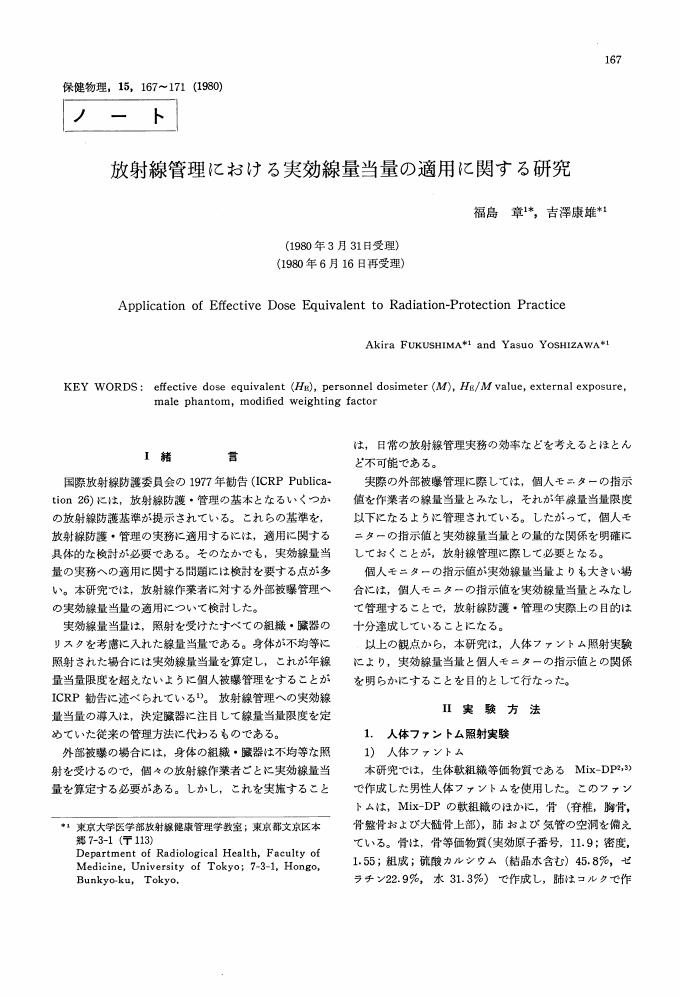13 0 0 0 OA 公衆の放射線防護の観点からみた国民線量 -その基本的考え方と線量評価-
- 著者
- 草間 朋子 中川 健朗 吉澤 康雄
- 出版者
- 日本保健物理学会
- 雑誌
- 保健物理 (ISSN:03676110)
- 巻号頁・発行日
- vol.20, no.4, pp.399-406, 1985 (Released:2010-02-25)
- 参考文献数
- 24
- 被引用文献数
- 1
The concept of population dose is of importance and of interest at the point of radiation protection of puplic. We devided it into two categories, source-related population dose and individual-related population dose, and estimated each population dose of Japan. We surveyed all sources that caused exposure to Japanese population. A number of sources, both naturally-occuring and man-made, contributed to population exposure. According to source-related dose assessment, average annual effective dose equivalent was about 3.3mSv, and about half of which, i. e. 1.6mSv, was given from medical exposure. And from the results of individual-related dose assessment we proposed the allocation of the annual dose limit of public for each controllable source, that is, 2.5mSv/yr to nuclear faculties, 1.0mSv/yr to miscellaneous sources, 1.5mSv/yr to probablistic exposure.
7 0 0 0 OA 放射線管理における実効線量当量の適用に関する研究
2 0 0 0 OA 放射性物質の誘導排水濃度基準に関する一考察
- 著者
- 岡村 泰治 小林 克彦 草間 朋子 吉澤 康雄
- 出版者
- Japan Health Physics Society
- 雑誌
- 保健物理 (ISSN:03676110)
- 巻号頁・発行日
- vol.19, no.3, pp.231-237, 1984 (Released:2010-02-25)
- 参考文献数
- 10
The values of Derived Limits of Effluent Water Concentration, (DLEC)w, have been estimated in accordance with the principles of the recent recommendations of the International Commission on Radiological Protection.The (DLEC)w's were derived from the Annual Limits on Intake for individual members of the public (ALIp), considering realistic models of exposure pathways and annual intake rates of foods. The ALIp's were decided after consideration of body organ mass and other age dependent parameters. We assumed that the materials which brought exposure to the public were drinking water, fish, seaweed, invertebrate and seashore. The age dependence of annual intake rate of food might be proportional to a person's energy expenditure rate. The following results were obtained. Infants were the critical group of the public at the time of derivation of (DLEC)w. The ALIp's for the infants were about one-hundredth of those for workers and their (DLEC)w's were about one-third of those for the adult members of the public.
2 0 0 0 OA 放射性物質による皮膚汚染の除染方法に関する実験的考察
- 著者
- 草間 朋子 伊藤 成 吉澤 康雄
- 出版者
- 日本保健物理学会
- 雑誌
- 保健物理 (ISSN:03676110)
- 巻号頁・発行日
- vol.21, no.3, pp.127-131, 1986 (Released:2010-02-25)
- 参考文献数
- 9
The present study was conducted to investigate the decontamination procedure for the skin contaminated with radioactive materials; those were cobalt-58 (58CoCl2), mangan-54 (54MnCl2) and radioactive CRUD (Chalk River Unidentified Deposit) and the skins of pigs were used. The procedures and materials used for decontamination were as follows: (1) 0.5% Hyamin solution, (2) brushing, (3) acid soap, (4) stripping cream, (5) cosmetic cleansing cream, (6) potassium permanganate and sodium thiosulfate solutions, (7) titanium oxide paste, and (8) their combination. Each procedure was performed for 2min, and repeated twice or 4 times at 15 or 60min after contamination. The residual radioactivity after decontamination procedure was measured with a 2×2 inch NaI (Tl) scintillation detector or a solid state detector. The following sequential procedure was most effective: washing with 0.5% Hyamin solution for 2min, brushing with acid soap, rubbing cosmetic cleansing cream and washing for 2min with tap water. Since this procedure is simple and not irritable, it is appropriate for human skin. The residual activities on the skin after this decontamination were about 20, 20 and 10% for cobalt, mangan and CRUD, respectively. When the decontamination with 0.5% Hyamin solution began within 15min after contanimation, the residual radioactivity was 3% of administered activity, but 60% in the case 60min after contamination. Thus, a noteworthy point for decontamination is to begin as soon as possible.
1 0 0 0 OA 創傷の放射能汚染に対する応急的な除染方法に関する実験的研究
- 著者
- 草間 朋子 大柿 一史 吉澤 康雄
- 出版者
- 日本保健物理学会
- 雑誌
- 保健物理 (ISSN:03676110)
- 巻号頁・発行日
- vol.17, no.2, pp.151-155, 1982 (Released:2010-02-25)
- 参考文献数
- 3
The present study was designed to investigate the decontamination procedures in first aid for wounds contaminated with radionuclides. Abrasion of mouse skin was contaminated with 58CoCl2. Irrigation by decontamination fluids began at 2min after administration of the radionuclide and continued for 14min. Tap water, 0.5% Hyamine solution or 10% Ca-DTPA solution were used as the decontamination fluids. Radioactivities of whole body, wounded skin surface and washed solution were measured with an animal counter with 5cm NaI (Tl) and a well-type auto-gamma-counter. Decontamination effectiveness were expressed as follows: (1) absorption rate of radionuclide through the wound and (2) residual rate of radionuclide on the wound. More than 20% of the radionuclide applied on the wounded skin was absorbed in 15min after contamination. The absorption rate decreased to 2% by the decontamination procedures. The Ca-DTPA solution reduced the residual rate of radionuclide on the wounds. The results suggested that the decontamination for the contaminated wounds should begin as soon as possible. Irrigation with 0.5% Hyamine solution has been advocated for the decontamination in the first aid.
